View in other NatureServe Network Field Guides
NatureServe
Montana
Utah
Wyoming
Idaho
Wisconsin
British Columbia
South Carolina
Yukon
California
New York
Schweinitz's Flatsedge - Cyperus schweinitzii
Other Names:
Schweinitz Flatsedge
State Rank Reason (see State Rank above)
Rare in Montana, where it is currently known from a few widely scattered sandy sites.
General Description
Rhizomatous perennial. Stems erect, 10–40 cm, bulbous-based. Leaves basal and lower-cauline, 1–2 mm wide, U-shaped in cross-section. Inflorescence of ovoid spikes of sessile spikelets. Spikelets somewhat compressed, 6–12 mm long. Scales green to tan, apiculate, 2.5–3.5 mm long, prominently veined. Flowers: stamens 3; style 3-branched. Achene elliptic, brown, 3-sided, 2–2.5 mm long, apiculate (
Lesica et al. 2012. Manual of Montana Vascular Plants. BRIT Press. Fort Worth, TX).
Phenology
Fruit mature in late June-July.
Diagnostic Characteristics
This is our only perennial Cyperus spp. and also the only one occurring in sandy, upland habitats.
Species Range
Montana Range
Range Descriptions
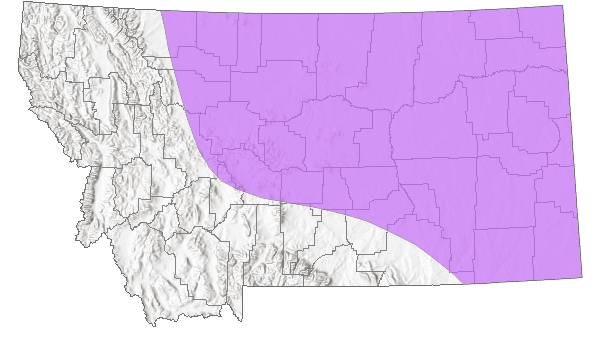
 Native
Native
Range Comments
AB to QC south to WA, NM, TX, KY, NY and Mexico (Lesica et al. 2012. Manual of Montana Vascular Plants. BRIT Press. Fort Worth, TX).
Observations in Montana Natural Heritage Program Database
Number of Observations: 46
(Click on the following maps and charts to see full sized version)
Map Help and Descriptions
Relative Density
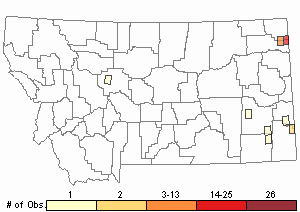
Recency
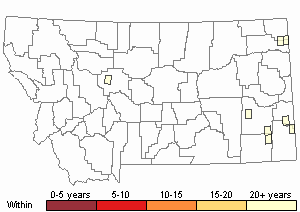

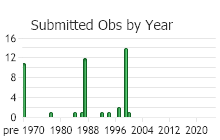
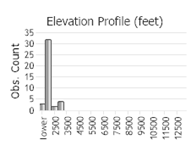 (Observations spanning multiple months or years are excluded from time charts)
(Observations spanning multiple months or years are excluded from time charts)
Habitat
Sparsely-vegetated, sandy-soiled, prairie grasslands on ridges and slopes often near sandstone outcrops or on sandy "blowouts". Commonly associated species include Oryzopsis hymenoides, Stipa comata, Sporobolus cryptandrus, Calamovilfa longifolia, Carex filifolia, Andropogon scoparius, Tradescantia occidentalis, Pinus ponderosa and Yucca glauca.
Ecological Systems Associated with this Species
Stewardship Responsibility
Threats or Limiting Factors
STATE THREAT SCORE REASON
Reported threats to Montana's populations of Schweinitz's Flatsedge include management actions that prevent or minimize natural disturbance (MTNHP Threat Assessment 2021). Populations are found in sand blowouts of dunes or plains where wind erosion has removed a section of accumulated sand sediments. Management actions that prevent fire, grazing or strong winds allow vegetation to stabilize ground surface substrates, eventually reducing available habitat for Schweinitz's Flatsedge.
References
- Literature Cited AboveLegend:
 View Online Publication
View Online Publication Lesica, P., M.T. Lavin, and P.F. Stickney. 2012. Manual of Montana Vascular Plants. Fort Worth, TX: BRIT Press. viii + 771 p.
Lesica, P., M.T. Lavin, and P.F. Stickney. 2012. Manual of Montana Vascular Plants. Fort Worth, TX: BRIT Press. viii + 771 p. MTNHP Threat Assessment. 2021. State Threat Score Assignment and Assessment of Reported Threats from 2006 to 2021 for State-listed Vascular Plants. Botany Program, Montana Natural Heritage Program, Helena, Montana.
MTNHP Threat Assessment. 2021. State Threat Score Assignment and Assessment of Reported Threats from 2006 to 2021 for State-listed Vascular Plants. Botany Program, Montana Natural Heritage Program, Helena, Montana.
- Additional ReferencesLegend:
 View Online Publication
View Online Publication
Do you know of a citation we're missing? Heidel, B.L., S.V. Cooper and C. Jean. 2000. Plant species of special concern and plant associations of Sheridan County, Montana. Report to U.S. Fish and Wildlife Service. Montana Natural Heritage Program, Helena, Montana. 96 p.
Heidel, B.L., S.V. Cooper and C. Jean. 2000. Plant species of special concern and plant associations of Sheridan County, Montana. Report to U.S. Fish and Wildlife Service. Montana Natural Heritage Program, Helena, Montana. 96 p. Lesica, P., M.T. Lavin, and P.F. Stickney. 2022. Manual of Montana Vascular Plants, Second Edition. Fort Worth, TX: BRIT Press. viii + 779 p.
Lesica, P., M.T. Lavin, and P.F. Stickney. 2022. Manual of Montana Vascular Plants, Second Edition. Fort Worth, TX: BRIT Press. viii + 779 p. Vanderhorst, J.P., S.V. Cooper, and B.L. Heidel. 1998. Botanical and vegetation survey of Carter County, Montana. Unpublished report prepared for the Bureau of Land Management. Montana Natural Heritage Program, Helena. 116 pp. + app.
Vanderhorst, J.P., S.V. Cooper, and B.L. Heidel. 1998. Botanical and vegetation survey of Carter County, Montana. Unpublished report prepared for the Bureau of Land Management. Montana Natural Heritage Program, Helena. 116 pp. + app.
- Web Search Engines for Articles on "Schweinitz's Flatsedge"





